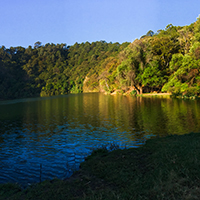Seasonal variation of Microcystis aeruginosa and factors related to blooms in a deep warm monomictic lake in Mexico

Accepted: 23 April 2021
Supplementary: 91
HTML: 21
All claims expressed in this article are solely those of the authors and do not necessarily represent those of their affiliated organizations, or those of the publisher, the editors and the reviewers. Any product that may be evaluated in this article or claim that may be made by its manufacturer is not guaranteed or endorsed by the publisher.
Authors
The occurrence of cyanobacterial blooms has increased globally over the last decades, with the combined effect of climate change and eutrophication as its main drivers. The seasonal dynamic of cyanobacterial blooms is a well-known phenomenon in lakes and reservoirs in temperate zones. Nevertheless, in the tropics, most studies have been performed in shallow and artificial lakes; therefore, the seasonal dynamic of cyanobacterial blooms in deep and eutrophic tropical lakes is still under research. We studied the seasonal variation of the phytoplankton community and the factors associated with Microcystis aeruginosa blooms along the water column of Lake Alberca de Tacámbaro, a warm monomictic crater lake located in Mexico, during 2018 and 2019. According to previous studies performed in 2006 and 2010, this lake was mesotrophic-eutrophic, with Chlorophyta and Bacillariophyta as the dominant groups of the phytoplankton community. During 2018 and 2019, the lake was eutrophic and occasionally, hypertrophic, a phenomenon likely associated with the increase of farmland area around the lake. The dominant species was M. aeruginosa, forming blooms from the surface to 10 m depth in winter, in the hypolimnion in spring and summer, and along the full water column in autumn. These findings suggest that M. aeruginosa in Lake Alberca de Tacámbaro displays seasonal and spatial population dynamics. Total phosphorus, dissolved inorganic nitrogen, water temperature and photosynthetically active radiation were the environmental factors related to M. aeruginosa blooms. Our results suggest that the changes in the structure of the phytoplankton community through time, and M. aeruginosa blooms in Lake Alberca de Tacámbaro, are mainly related to changes in land use from forest to farmland in areas adjacent to the lake, which promoted its eutrophication in the last years through runoffs. Comparative studies with other deep and eutrophic lakes will allow us to gain a deeper understanding of the dynamic of cyanobacterial blooms in natural and artificial water reservoirs strongly stressed by human activities.
Edited by
Diego Fontaneto, CNR-IRSA Water Research Institute, Verbania, ItalyHow to Cite

This work is licensed under a Creative Commons Attribution-NonCommercial 4.0 International License.
Similar Articles
- Silvia Marková, Catia Maurone, Erica Racchetti, Marco Bartoli, Valeria Rossi, Daphnia diversity in water bodies of the Po River Basin , Journal of Limnology: Vol. 76 No. 2 (2017)
- Giuseppe MORABITO, Delio RUGGIU, Pierisa PANZANI, Trends of phytoplankton characteristics and their communities in pre- and post-liming time in Lake Orta (1984-1998) , Journal of Limnology: Vol. 60 No. 1 (2001)
- Enlou ZHANG, Enfeng LIU, Richard JONES, Peter LANGDON, Xiangdong YANG, Ji SHEN, A 150-year record of recent changes in human activity and eutrophication of Lake Wushan from the middle reach of the Yangze River, China , Journal of Limnology: Vol. 69 No. 2 (2010)
- Carla BONACINA, Andrea PASTERIS, Zooplankton of Lake Orta after liming: an eleven years study , Journal of Limnology: Vol. 60 No. 1 (2001)
- Fabio BUZZI, Phytoplankton assemblages in two sub-basins of Lake Como , Journal of Limnology: Vol. 61 No. 1 (2002)
- Emilia Rota, Marco Bartoli, Alex Laini, First time in Italy. Is the elusive aquatic megadrile Sparganophilus Benham, 1892 (Annelida, Clitellata) accelerating its dispersal in Europe? , Journal of Limnology: Vol. 73 No. 3 (2014)
- Brigitte HINDER, Isabel BAUR, Kurt HANSELMANN, Ferdinand SCHANZ, Microbial food web in an oligotrophic high mountain lake (Jöri Lake III, Switzerland) , Journal of Limnology: Vol. 58 No. 2 (1999)
- Moshe GOPHEN, Water quality management in Lake Kinneret (Israel): hydrological and food web perspectives , Journal of Limnology: Vol. 62 No. s1 (2003): Residence Time in Lakes: Science, Management, Education
- Cristiana CALLIERI, Alessandra PUGNETTI, Marina MANCA, Carbon partitioning in the food web of a high mountain lake: from bacteria to zooplankton , Journal of Limnology: Vol. 58 No. 2 (1999)
- David Gutiérrez, Romina Álvarez-Troncoso, Yasmina Martínez-Barciela, Alejandro Polina, Josefina Garrido, Influence of wastewater discharges on benthic macroinvertebrate communities in a Cantabrian-Atlantic coastal river , Journal of Limnology: Vol. 81 (2022)
<< < 41 42 43 44 45 46 47 48 49 50 > >>
You may also start an advanced similarity search for this article.
-
Richard Mugani, Fatima El Khalloufi, Minoru Kasada, El Mahdi Redouane, Mohammed Haida, Roseline Prisca Aba, Yasser Essadki, Soukaina El Amrani Zerrifi, Sven-Oliver Herter, Abdessamad Hejjaj, Faissal Aziz, Naaila Ouazzani, Joana Azevedo, Alexandre Campos, Anke Putschew, Hans-Peter Grossart, Laila Mandi, Vitor Vasconcelos, Brahim OudraHarmful Algae : 2024
-
Gerardo Ávila-Torres, Gabriela Rosiles-González, Victor Hugo Carrillo-Jovel, Gilberto Acosta-González, Eduardo Cejudo-Espinosa, Daniela Ortega-Camacho, Cecilia Hernández-Zepeda, Oscar Alberto Moreno ValenzuelaMicrobiology Research : 2023
-
Daisy Valera Fernández, Beatriz Ortega Guerrero, Elizabeth Solleiro Rebolledo, Cecilia Irene Caballero MirandaGeofísica Internacional : 2024

 https://doi.org/10.4081/jlimnol.2021.2013
https://doi.org/10.4081/jlimnol.2021.2013





